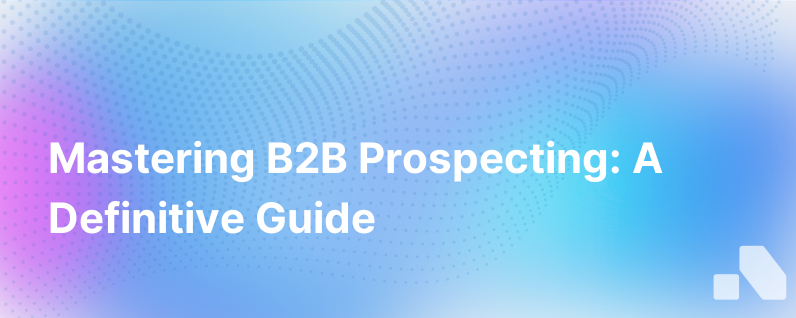
B2B prospecting is the lifeblood of sales. In an ever-evolving business environment, the ability to seek out and engage potential clients is not just a foundational aspect of a thriving enterprise—it's a vital skill that must be continually honed and applied within any forward-looking sales strategy.
However, as someone entrenched in the nuances of B2B sales, I can attest that not all prospecting is created equal. The most successful businesses implement prospecting as an ongoing, systematic process defined by its precision, personalization, and persistence. Aomni, as an AI-driven platform facilitating repetitive and data-heavy tasks, supports this doctrine, but the human element remains indispensable.
In this guide, I will distill the core elements of B2B prospecting into actionable strategies, drawing from vast industry knowledge and current best practices.
Understanding the Landscape of B2B Prospecting
First and foremost, B2B prospecting extends beyond merely identifying potential buyers. It encompasses:
- Target Identification: Pinpointing businesses that would benefit the most from your product or service based on industry, size, revenue, and market position.
- Outreach Preparation: Gearing up your sales team with comprehensive intel on prospects to tailor communication.
- Engagement Strategy: Articulating a multi-faceted approach to compel conversations and nurture leads.
- Pipeline Management: Ensuring that each lead is appropriately categorized, followed up with, and progressed through the sales funnel.
The strategic overview may feel monumental, but it embodies a trove of micro-processes, each critical to the prospecting mission.
The Fusion of Art and Science in B2B Prospecting
To demystify what makes B2B prospecting tick, consider it a fusion of art and science. The 'science' is the systematic approach based on data, research, and analytics. The 'art' is the human touch—the nuanced communication, the personal relationships, and the understanding of each prospect's unique needs and pain points.
The Science: Data-Driven Decisiveness
In the age of information, the database is the prospecting arsenal from which you secure the tools of engagement.
- Utilize Advanced Analytics and Tools: Leverage platforms that integrate with customer relationship management (CRM) systems, like Salesforce, to qualify leads accurately. Aomni, for example, can automatically process vast swathes of data to segment and prioritize prospects based on predetermined criteria.
- Develop a Robust ICP: Your Ideal Customer Profile (ICP) boils down to the type of business that has the problem your solution can solve. It's the epitome of data-driven profiling.
- Employ Predictive Analysis: Utilize AI to predict buying patterns and behaviors, enhancing the precision of your targeting.
The Art: Crafting Connections
On the flip side, the 'art' demands the kind of creativity that can't be algorithmically coded.
- Personalize Prospecting: This means going beyond "First Name" tags in templated emails. It implies thoughtfully crafting messages that resonate personally and professionally with the prospect.
- Quality over Quantity: A hundred generic, scattered calls a day pale in effectiveness to ten well-researched, personalized pitches. It's about making each touchpoint count.
- Storytelling: Weaving your product into a compelling narrative is key. Successful salespeople position their offering not as a mere tool but as a critical chapter in their prospect's success story.
Both the 'art' and 'science' of prospecting are mutually reinforcing. Science provides the map—art navigates the terrain.
Methodological Prospecting: A Structured Approach
A structured approach is a hallmark of efficient prospecting. This often involves several stages:
- Research and Segment: The first phase involves intensive research to understand the prospect's business, industry challenges, opportunities, and who the decision-makers are. Segmentation organically unfolds from this step, categorizing prospects into tiers based on potential value and likelihood to buy.
- Reach Out: When reaching out, ensure multiple touchpoints across different channels—calls, emails, social media, etc. However, each interaction should be purposeful and in-line with the prospect's preferred mode of communication.
- Follow Up and Nurture: It’s a fundamental truth in sales that the follow-up is where the magic happens. Regular checks—without bordering on intrusion—maintain the dialogue, nurturing the potential client to fruition.
- Assess and Optimize: Critical analysis of what works and what doesn’t is essential. Use A/B testing for emails, track call-to-conversation ratios, and continually refine your approach based on feedback and conversion rates.
Prospecting Tactics That Yield Results
Certain tactics tend to rise to the top for effectiveness:
- Refine Your Elevator Pitch: Prospects are busy. You typically have mere seconds to capture interest. Make sure your pitch is concise, compelling, and speaks directly to how you can address their challenges.
- Utilize Content Marketing: High-quality, informative content can attract potential customers and provide value upfront.
- Capitalize on Referrals: Leverage the networks of your satisfied customers. Warm introductions ramp up the trust factor significantly.
- Invest in Sales Training: Equip your team with the latest insights on B2B buying behaviors and effective communication strategies.
Conclusion
In B2B prospecting, the divide between success and stagnation lies in how effectively you can blend the science of methodological groundwork with the art of personal connection. Platforms like Aomni facilitate this blend by empowering your team with actionable insights that human agents can translate into empathetic and impactful sales narratives.
Every prospect represents not just a potential deal but an opportunity to refine your approach, build your brand's reputation, and, ultimately, contribute to the grand tapestry of your business’s legacy.
By fully endorsing both the analytical and relational aspects of prospecting, startups can significantly improve their reach and revenue generation. With discipline, creativity, and a finger always on the pulse of innovation, the art of securing prospects need not be a daunting task—but rather, an adventure in strategic relationship building.